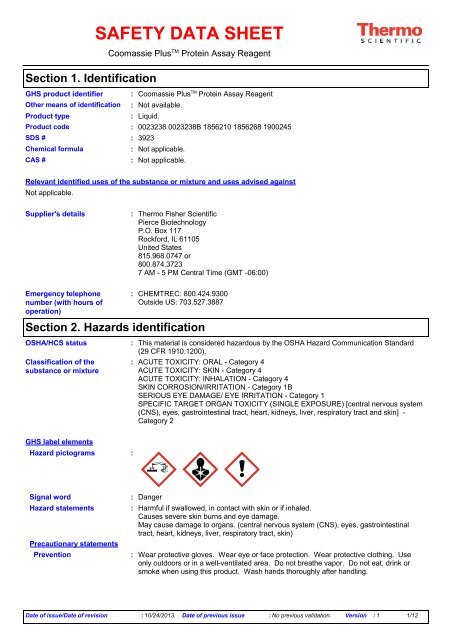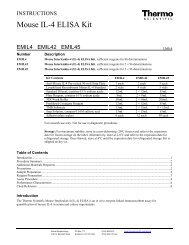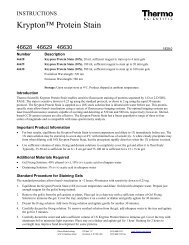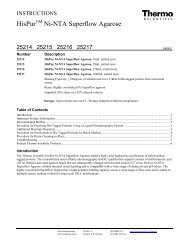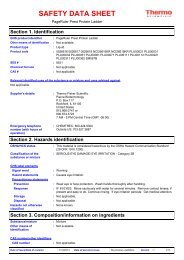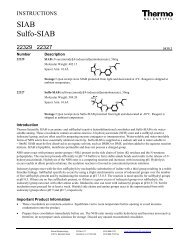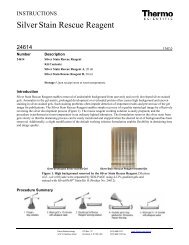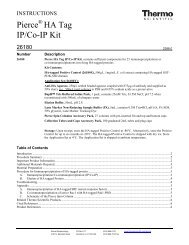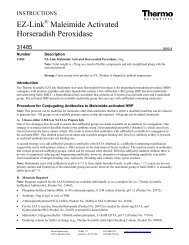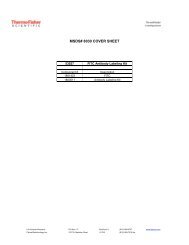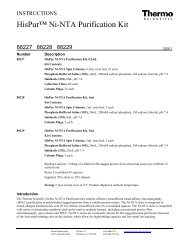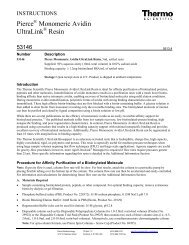Page 1 Coomassie PlusTM Protein Assay Reagent 0023238 ...
Page 1 Coomassie PlusTM Protein Assay Reagent 0023238 ...
Page 1 Coomassie PlusTM Protein Assay Reagent 0023238 ...
Create successful ePaper yourself
Turn your PDF publications into a flip-book with our unique Google optimized e-Paper software.
SAFETY DATA SHEET<br />
<strong>Coomassie</strong> Plus TM <strong>Protein</strong> <strong>Assay</strong> <strong>Reagent</strong><br />
Section 1. Identification<br />
GHS product identifier<br />
Other means of identification<br />
Product type<br />
Product code<br />
SDS #<br />
Chemical formula<br />
CAS #<br />
:<br />
:<br />
:<br />
:<br />
:<br />
:<br />
:<br />
<strong>Coomassie</strong> Plus TM <strong>Protein</strong> <strong>Assay</strong> <strong>Reagent</strong><br />
Not available.<br />
Liquid.<br />
<strong>0023238</strong> <strong>0023238</strong>B 1856210 1856268 1900245<br />
3923<br />
Not applicable.<br />
Not applicable.<br />
Relevant identified uses of the substance or mixture and uses advised against<br />
Not applicable.<br />
Supplier's details<br />
: Thermo Fisher Scientific<br />
Pierce Biotechnology<br />
P.O. Box 117<br />
Rockford, IL 61105<br />
United States<br />
815.968.0747 or<br />
800.874.3723<br />
7 AM - 5 PM Central Time (GMT -06:00)<br />
Emergency telephone<br />
number (with hours of<br />
operation)<br />
:<br />
CHEMTREC: 800.424.9300<br />
Outside US: 703.527.3887<br />
Section 2. Hazards identification<br />
OSHA/HCS status<br />
Classification of the<br />
substance or mixture<br />
: This material is considered hazardous by the OSHA Hazard Communication Standard<br />
(29 CFR 1910.1200).<br />
:<br />
ACUTE TOXICITY: ORAL - Category 4<br />
ACUTE TOXICITY: SKIN - Category 4<br />
ACUTE TOXICITY: INHALATION - Category 4<br />
SKIN CORROSION/IRRITATION - Category 1B<br />
SERIOUS EYE DAMAGE/ EYE IRRITATION - Category 1<br />
SPECIFIC TARGET ORGAN TOXICITY (SINGLE EXPOSURE) [central nervous system<br />
(CNS), eyes, gastrointestinal tract, heart, kidneys, liver, respiratory tract and skin] -<br />
Category 2<br />
GHS label elements<br />
Hazard pictograms :<br />
Signal word<br />
Hazard statements<br />
Precautionary statements<br />
Prevention<br />
: Danger<br />
: Harmful if swallowed, in contact with skin or if inhaled.<br />
Causes severe skin burns and eye damage.<br />
May cause damage to organs. (central nervous system (CNS), eyes, gastrointestinal<br />
tract, heart, kidneys, liver, respiratory tract, skin)<br />
: Wear protective gloves. Wear eye or face protection. Wear protective clothing. Use<br />
only outdoors or in a well-ventilated area. Do not breathe vapor. Do not eat, drink or<br />
smoke when using this product. Wash hands thoroughly after handling.<br />
Date of issue/Date of revision : 10/24/2013. Date of previous issue : No previous validation. Version : 1 1/12
<strong>Coomassie</strong> Plus TM <strong>Protein</strong> <strong>Assay</strong> <strong>Reagent</strong><br />
Section 2. Hazards identification<br />
Response<br />
Storage<br />
Disposal<br />
Supplemental label<br />
elements<br />
Hazards not otherwise<br />
classified<br />
: IF exposed or if you feel unwell: Call a POISON CENTER or physician. IF INHALED:<br />
Remove victim to fresh air and keep at rest in a position comfortable for breathing.<br />
Immediately call a POISON CENTER or physician. IF SWALLOWED: Immediately call<br />
a POISON CENTER or physician. Rinse mouth. Do NOT induce vomiting. IF ON SKIN<br />
(or hair): Take off immediately all contaminated clothing. Rinse skin with water or<br />
shower. Wash contaminated clothing before reuse. Immediately call a POISON<br />
CENTER or physician. IF ON SKIN: Wash with plenty of soap and water. Call a<br />
POISON CENTER or physician if you feel unwell. IF IN EYES: Rinse cautiously with<br />
water for several minutes. Remove contact lenses, if present and easy to do. Continue<br />
rinsing. Immediately call a POISON CENTER or physician.<br />
: Store locked up.<br />
: Dispose of contents and container in accordance with all local, regional, national and<br />
international regulations.<br />
: Do not taste or swallow. Wash thoroughly after handling.<br />
: Causes digestive tract burns.<br />
Section 3. Composition/information on ingredients<br />
Substance/mixture<br />
Other means of<br />
identification<br />
:<br />
Mixture<br />
: Not available.<br />
CAS number/other identifiers<br />
CAS number<br />
: Not applicable.<br />
Ingredient name<br />
CAS number<br />
phosphoric acid 7 - 10 7664-38-2<br />
methanol 3 - 5 67-56-1<br />
Any concentration shown as a range is to protect confidentiality or is due to batch variation.<br />
There are no additional ingredients present which, within the current knowledge of the supplier and in the<br />
concentrations applicable, are classified as hazardous to health or the environment and hence require reporting in<br />
this section.<br />
Occupational exposure limits, if available, are listed in Section 8.<br />
Section 4. First aid measures<br />
Description of necessary first aid measures<br />
Eye contact<br />
Inhalation<br />
Skin contact<br />
:<br />
:<br />
:<br />
Get medical attention immediately. Call a poison center or physician. Immediately flush<br />
eyes with plenty of water, occasionally lifting the upper and lower eyelids. Check for and<br />
remove any contact lenses. Continue to rinse for at least 10 minutes. Chemical burns<br />
must be treated promptly by a physician.<br />
Get medical attention immediately. Call a poison center or physician. Remove victim to<br />
fresh air and keep at rest in a position comfortable for breathing. If it is suspected that<br />
fumes are still present, the rescuer should wear an appropriate mask or self-contained<br />
breathing apparatus. If not breathing, if breathing is irregular or if respiratory arrest<br />
occurs, provide artificial respiration or oxygen by trained personnel. It may be dangerous<br />
to the person providing aid to give mouth-to-mouth resuscitation. If unconscious, place<br />
in recovery position and get medical attention immediately. Maintain an open airway.<br />
Loosen tight clothing such as a collar, tie, belt or waistband.<br />
Get medical attention immediately. Call a poison center or physician. Wash with plenty<br />
of soap and water. Remove contaminated clothing and shoes. Wash contaminated<br />
clothing thoroughly with water before removing it, or wear gloves. Continue to rinse for at<br />
least 10 minutes. Chemical burns must be treated promptly by a physician. Wash<br />
clothing before reuse. Clean shoes thoroughly before reuse.<br />
%<br />
Date of issue/Date of revision : 10/24/2013. Date of previous issue : No previous validation. Version : 1 2/12
<strong>Coomassie</strong> Plus TM <strong>Protein</strong> <strong>Assay</strong> <strong>Reagent</strong><br />
Section 4. First aid measures<br />
Ingestion :<br />
Get medical attention immediately. Call a poison center or physician. Wash out mouth<br />
with water. Remove dentures if any. Remove victim to fresh air and keep at rest in a<br />
position comfortable for breathing. If material has been swallowed and the exposed<br />
person is conscious, give small quantities of water to drink. Stop if the exposed person<br />
feels sick as vomiting may be dangerous. Do not induce vomiting unless directed to do<br />
so by medical personnel. If vomiting occurs, the head should be kept low so that vomit<br />
does not enter the lungs. Chemical burns must be treated promptly by a physician.<br />
Never give anything by mouth to an unconscious person. If unconscious, place in<br />
recovery position and get medical attention immediately. Maintain an open airway.<br />
Loosen tight clothing such as a collar, tie, belt or waistband.<br />
Most important symptoms/effects, acute and delayed<br />
Potential acute health effects<br />
Eye contact<br />
Inhalation<br />
Skin contact<br />
:<br />
Causes serious eye damage.<br />
: Harmful if inhaled. May give off gas, vapor or dust that is very irritating or corrosive to<br />
the respiratory system.<br />
: Causes severe burns. Harmful in contact with skin.<br />
Ingestion<br />
: Harmful if swallowed. Corrosive to the digestive tract. Causes burns. May cause burns<br />
to mouth, throat and stomach.<br />
Over-exposure signs/symptoms<br />
Eye contact<br />
Inhalation<br />
Skin contact<br />
Ingestion<br />
: Adverse symptoms may include the following:<br />
pain<br />
watering<br />
redness<br />
: No specific data.<br />
:<br />
:<br />
Adverse symptoms may include the following:<br />
pain or irritation<br />
redness<br />
blistering may occur<br />
Adverse symptoms may include the following:<br />
stomach pains<br />
Indication of immediate medical attention and special treatment needed, if necessary<br />
Notes to physician<br />
Specific treatments<br />
Protection of first-aiders<br />
: Treat symptomatically. Contact poison treatment specialist immediately if large<br />
quantities have been ingested or inhaled.<br />
: No specific treatment.<br />
: No action shall be taken involving any personal risk or without suitable training. If it is<br />
suspected that fumes are still present, the rescuer should wear an appropriate mask or<br />
self-contained breathing apparatus. It may be dangerous to the person providing aid to<br />
give mouth-to-mouth resuscitation. Wash contaminated clothing thoroughly with water<br />
before removing it, or wear gloves.<br />
See toxicological information (Section 11)<br />
Section 5. Fire-fighting measures<br />
Extinguishing media<br />
Suitable extinguishing<br />
media<br />
Unsuitable extinguishing<br />
media<br />
:<br />
:<br />
Use an extinguishing agent suitable for the surrounding fire.<br />
None known.<br />
Specific hazards arising<br />
from the chemical<br />
Hazardous thermal<br />
decomposition products<br />
:<br />
:<br />
In a fire or if heated, a pressure increase will occur and the container may burst.<br />
Decomposition products may include the following materials:<br />
carbon dioxide<br />
carbon monoxide<br />
phosphorus oxides<br />
Date of issue/Date of revision : 10/24/2013. Date of previous issue : No previous validation. Version : 1 3/12
<strong>Coomassie</strong> Plus TM <strong>Protein</strong> <strong>Assay</strong> <strong>Reagent</strong><br />
Section 5. Fire-fighting measures<br />
Special protective actions<br />
for fire-fighters<br />
Special protective<br />
equipment for fire-fighters<br />
:<br />
:<br />
Section 6. Accidental release measures<br />
Promptly isolate the scene by removing all persons from the vicinity of the incident if<br />
there is a fire. No action shall be taken involving any personal risk or without suitable<br />
training.<br />
Fire-fighters should wear appropriate protective equipment and self-contained breathing<br />
apparatus (SCBA) with a full face-piece operated in positive pressure mode.<br />
Personal precautions, protective equipment and emergency procedures<br />
For non-emergency<br />
personnel<br />
For emergency responders<br />
: No action shall be taken involving any personal risk or without suitable training.<br />
Evacuate surrounding areas. Keep unnecessary and unprotected personnel from<br />
entering. Do not touch or walk through spilled material. Do not breathe vapor or mist.<br />
Provide adequate ventilation. Wear appropriate respirator when ventilation is inadequate.<br />
Put on appropriate personal protective equipment.<br />
: If specialised clothing is required to deal with the spillage, take note of any information in<br />
Section 8 on suitable and unsuitable materials. See also the information in "For nonemergency<br />
personnel".<br />
Environmental precautions<br />
:<br />
Avoid dispersal of spilled material and runoff and contact with soil, waterways, drains and<br />
sewers. Inform the relevant authorities if the product has caused environmental pollution<br />
(sewers, waterways, soil or air).<br />
Methods and materials for containment and cleaning up<br />
Small spill :<br />
Large spill :<br />
Section 7. Handling and storage<br />
Stop leak if without risk. Move containers from spill area. Dilute with water and mop up<br />
if water-soluble. Alternatively, or if water-insoluble, absorb with an inert dry material and<br />
place in an appropriate waste disposal container. Dispose of via a licensed waste<br />
disposal contractor.<br />
Stop leak if without risk. Move containers from spill area. Approach release from upwind.<br />
Prevent entry into sewers, water courses, basements or confined areas. Wash spillages<br />
into an effluent treatment plant or proceed as follows. Contain and collect spillage with<br />
non-combustible, absorbent material e.g. sand, earth, vermiculite or diatomaceous earth<br />
and place in container for disposal according to local regulations (see Section 13).<br />
Dispose of via a licensed waste disposal contractor. Contaminated absorbent material<br />
may pose the same hazard as the spilled product. Note: see Section 1 for emergency<br />
contact information and Section 13 for waste disposal.<br />
Precautions for safe handling<br />
Protective measures<br />
Advice on general<br />
occupational hygiene<br />
:<br />
:<br />
Put on appropriate personal protective equipment (see Section 8). Do not get in eyes or<br />
on skin or clothing. Do not breathe vapor or mist. Do not ingest. Use only with adequate<br />
ventilation. Wear appropriate respirator when ventilation is inadequate. Keep in the<br />
original container or an approved alternative made from a compatible material, kept<br />
tightly closed when not in use. Empty containers retain product residue and can be<br />
hazardous. Do not reuse container.<br />
Eating, drinking and smoking should be prohibited in areas where this material is handled,<br />
stored and processed. Workers should wash hands and face before eating, drinking and<br />
smoking. Remove contaminated clothing and protective equipment before entering<br />
eating areas. See also Section 8 for additional information on hygiene measures.<br />
Conditions for safe storage,<br />
including any<br />
incompatibilities<br />
:<br />
Store between the following temperatures: 2 to 8°C (35.6 to 46.4°F). Store in<br />
accordance with local regulations. Store in original container protected from direct<br />
sunlight in a dry, cool and well-ventilated area, away from incompatible materials (see<br />
Section 10) and food and drink. Store locked up. Keep container tightly closed and<br />
sealed until ready for use. Containers that have been opened must be carefully resealed<br />
and kept upright to prevent leakage. Do not store in unlabeled containers. Use<br />
appropriate containment to avoid environmental contamination.<br />
Date of issue/Date of revision : 10/24/2013. Date of previous issue : No previous validation. Version : 1 4/12
<strong>Coomassie</strong> Plus TM <strong>Protein</strong> <strong>Assay</strong> <strong>Reagent</strong><br />
Section 8. Exposure controls/personal protection<br />
Control parameters<br />
Occupational exposure limits<br />
Ingredient name<br />
phosphoric acid<br />
methanol<br />
Exposure limits<br />
ACGIH (United States).<br />
TWA: 1 mg/m³<br />
STEL: 3 mg/m³<br />
NIOSH (United States, 0/1994).<br />
TWA: 1 mg/m³<br />
STEL: 3 mg/m³<br />
OSHA (United States, 0/1989).<br />
TWA: 1 mg/m³<br />
STEL: 3 mg/m³<br />
ACGIH TLV (United States, 3/2012).<br />
STEL: 3 mg/m³ 15 minutes.<br />
TWA: 1 mg/m³ 8 hours.<br />
NIOSH REL (United States, 1/2013).<br />
STEL: 3 mg/m³ 15 minutes.<br />
TWA: 1 mg/m³ 10 hours.<br />
OSHA PEL (United States, 6/2010).<br />
TWA: 1 mg/m³ 8 hours.<br />
OSHA PEL 1989 (United States, 3/1989).<br />
STEL: 3 mg/m³ 15 minutes.<br />
TWA: 1 mg/m³ 8 hours.<br />
ACGIH (United States, 0/2003). Absorbed<br />
through skin.<br />
CEIL: 200 ppm<br />
ACGIH (United States). Absorbed through<br />
skin.<br />
STEL: 250 ppm<br />
TWA: 200 ppm<br />
MSHA (United States). Absorbed through<br />
skin.<br />
TWA: 260 mg/m³<br />
NIOSH (United States). Absorbed through<br />
skin.<br />
STEL: 250 ppm<br />
TWA: 200 ppm<br />
OSHA (United States, 0/2003). Absorbed<br />
through skin.<br />
STEL: 250 ppm<br />
TWA: 200 ppm<br />
ACGIH TLV (United States, 3/2012).<br />
Absorbed through skin.<br />
STEL: 328 mg/m³ 15 minutes.<br />
STEL: 250 ppm 15 minutes.<br />
TWA: 262 mg/m³ 8 hours.<br />
TWA: 200 ppm 8 hours.<br />
NIOSH REL (United States, 1/2013).<br />
Absorbed through skin.<br />
STEL: 325 mg/m³ 15 minutes.<br />
STEL: 250 ppm 15 minutes.<br />
TWA: 260 mg/m³ 10 hours.<br />
TWA: 200 ppm 10 hours.<br />
OSHA PEL (United States, 6/2010).<br />
TWA: 260 mg/m³ 8 hours.<br />
TWA: 200 ppm 8 hours.<br />
OSHA PEL 1989 (United States, 3/1989).<br />
Absorbed through skin.<br />
STEL: 325 mg/m³ 15 minutes.<br />
STEL: 250 ppm 15 minutes.<br />
TWA: 260 mg/m³ 8 hours.<br />
TWA: 200 ppm 8 hours.<br />
Date of issue/Date of revision : 10/24/2013. Date of previous issue : No previous validation. Version : 1 5/12
<strong>Coomassie</strong> Plus TM <strong>Protein</strong> <strong>Assay</strong> <strong>Reagent</strong><br />
Section 8. Exposure controls/personal protection<br />
Appropriate engineering<br />
controls<br />
Environmental exposure<br />
controls<br />
: Use only with adequate ventilation. Use process enclosures, local exhaust ventilation or<br />
other engineering controls to keep worker exposure to airborne contaminants below any<br />
recommended or statutory limits.<br />
: Emissions from ventilation or work process equipment should be checked to ensure they<br />
comply with the requirements of environmental protection legislation. In some cases,<br />
fume scrubbers, filters or engineering modifications to the process equipment will be<br />
necessary to reduce emissions to acceptable levels.<br />
Individual protection measures<br />
Hygiene measures :<br />
Eye/face protection<br />
Skin protection<br />
Hand protection<br />
Body protection<br />
Other skin protection<br />
Respiratory protection :<br />
:<br />
:<br />
Wash hands, forearms and face thoroughly after handling chemical products, before<br />
eating, smoking and using the lavatory and at the end of the working period. Appropriate<br />
techniques should be used to remove potentially contaminated clothing. Wash<br />
contaminated clothing before reusing. Ensure that eyewash stations and safety showers<br />
are close to the workstation location.<br />
Safety eyewear complying with an approved standard should be used when a risk<br />
assessment indicates this is necessary to avoid exposure to liquid splashes, mists,<br />
gases or dusts. If contact is possible, the following protection should be worn, unless the<br />
assessment indicates a higher degree of protection: chemical splash goggles and/or<br />
face shield. If inhalation hazards exist, a full-face respirator may be required instead.<br />
Chemical-resistant, impervious gloves complying with an approved standard should be<br />
worn at all times when handling chemical products if a risk assessment indicates this is<br />
necessary. Considering the parameters specified by the glove manufacturer, check<br />
during use that the gloves are still retaining their protective properties. It should be noted<br />
that the time to breakthrough for any glove material may be different for different glove<br />
manufacturers. In the case of mixtures, consisting of several substances, the protection<br />
time of the gloves cannot be accurately estimated.<br />
: Personal protective equipment for the body should be selected based on the task being<br />
performed and the risks involved and should be approved by a specialist before handling<br />
this product.<br />
: Appropriate footwear and any additional skin protection measures should be selected<br />
based on the task being performed and the risks involved and should be approved by a<br />
specialist before handling this product.<br />
Use a properly fitted, air-purifying or air-fed respirator complying with an approved<br />
standard if a risk assessment indicates this is necessary. Respirator selection must be<br />
based on known or anticipated exposure levels, the hazards of the product and the safe<br />
working limits of the selected respirator.<br />
Section 9. Physical and chemical properties<br />
Appearance<br />
Physical state<br />
Color<br />
Odor<br />
Odor threshold<br />
pH<br />
Melting point<br />
Boiling point<br />
Evaporation rate<br />
:<br />
:<br />
:<br />
:<br />
:<br />
:<br />
Liquid.<br />
Brown. [Dark]<br />
Not available.<br />
Not available.<br />
Not available.<br />
Not available.<br />
Flash point : [Product does not sustain combustion.]<br />
Burning time<br />
Burning rate<br />
Flammability (solid, gas)<br />
Lower and upper explosive<br />
(flammable) limits<br />
: Not available.<br />
: Not applicable.<br />
:<br />
:<br />
Not applicable.<br />
Not available.<br />
: Not available.<br />
: Not available.<br />
Date of issue/Date of revision : 10/24/2013. Date of previous issue : No previous validation. Version : 1 6/12
<strong>Coomassie</strong> Plus TM <strong>Protein</strong> <strong>Assay</strong> <strong>Reagent</strong><br />
Section 9. Physical and chemical properties<br />
Vapor pressure<br />
Vapor density<br />
Relative density<br />
Solubility<br />
Solubility in water<br />
Partition coefficient: n-<br />
octanol/water<br />
Auto-ignition temperature<br />
Decomposition temperature<br />
SADT<br />
Viscosity<br />
:<br />
:<br />
:<br />
:<br />
:<br />
:<br />
:<br />
:<br />
Not available.<br />
Not available.<br />
Not available.<br />
Not available.<br />
: Not available.<br />
Not available.<br />
Not available.<br />
: Not available.<br />
Not available.<br />
Not available.<br />
Section 10. Stability and reactivity<br />
Reactivity<br />
: No specific test data related to reactivity available for this product or its ingredients.<br />
Chemical stability<br />
:<br />
The product is stable.<br />
Possibility of hazardous<br />
reactions<br />
: Under normal conditions of storage and use, hazardous reactions will not occur.<br />
Conditions to avoid<br />
:<br />
No specific data.<br />
Incompatible materials :<br />
No specific data.<br />
Hazardous decomposition<br />
products<br />
Section 11. Toxicological information<br />
Information on toxicological effects<br />
Acute toxicity<br />
:<br />
Under normal conditions of storage and use, hazardous decomposition products should<br />
not be produced.<br />
Product/ingredient name Result Species Dose Exposure<br />
phosphoric acid LD50 Dermal Rabbit 2730 mg/kg -<br />
LD50 Oral Rat 1.25 g/kg -<br />
methanol LC50 Inhalation Gas. Rat 145000 ppm 1 hours<br />
LC50 Inhalation Gas. Rat 64000 ppm 4 hours<br />
LC50 Inhalation Vapor Rat 83.2 mg/l 4 hours<br />
LD50 Dermal Rabbit 15800 mg/kg -<br />
LD50 Oral Rat 5600 mg/kg -<br />
Irritation/Corrosion<br />
Product/ingredient name Result Species Score Exposure Observation<br />
methanol Eyes - Moderate irritant Rabbit - 24 hours 100 -<br />
milligrams<br />
Eyes - Moderate irritant Rabbit - 40 milligrams -<br />
Skin - Moderate irritant Rabbit - 24 hours 20<br />
milligrams<br />
-<br />
Sensitization<br />
Not available.<br />
Mutagenicity<br />
Not available.<br />
Carcinogenicity<br />
Not available.<br />
Date of issue/Date of revision : 10/24/2013. Date of previous issue : No previous validation. Version : 1 7/12
<strong>Coomassie</strong> Plus TM <strong>Protein</strong> <strong>Assay</strong> <strong>Reagent</strong><br />
Section 11. Toxicological information<br />
Classification<br />
Product/ingredient name<br />
OSHA<br />
IARC<br />
NTP<br />
methanol None. - -<br />
Reproductive toxicity<br />
Not available.<br />
Teratogenicity<br />
Not available.<br />
Specific target organ toxicity (single exposure)<br />
Name<br />
Category<br />
Route of<br />
exposure<br />
Target organs<br />
methanol Category 1 Not determined central nervous<br />
system (CNS), eyes,<br />
gastrointestinal<br />
tract, heart, kidneys,<br />
liver, respiratory<br />
tract and skin<br />
Specific target organ toxicity (repeated exposure)<br />
Not available.<br />
Aspiration hazard<br />
Not available.<br />
Information on the likely<br />
routes of exposure<br />
Potential acute health effects<br />
Eye contact<br />
Inhalation<br />
Skin contact<br />
Ingestion<br />
: Routes of entry anticipated: Oral, Dermal, Inhalation.<br />
:<br />
: Harmful if inhaled. May give off gas, vapor or dust that is very irritating or corrosive to<br />
the respiratory system.<br />
: Causes severe burns. Harmful in contact with skin.<br />
:<br />
Causes serious eye damage.<br />
Harmful if swallowed. Corrosive to the digestive tract. Causes burns. May cause burns<br />
to mouth, throat and stomach.<br />
Symptoms related to the physical, chemical and toxicological characteristics<br />
Eye contact<br />
Inhalation<br />
Skin contact<br />
Ingestion<br />
: Adverse symptoms may include the following:<br />
pain<br />
watering<br />
redness<br />
: No specific data.<br />
:<br />
:<br />
Adverse symptoms may include the following:<br />
pain or irritation<br />
redness<br />
blistering may occur<br />
Adverse symptoms may include the following:<br />
stomach pains<br />
Delayed and immediate effects and also chronic effects from short and long term exposure<br />
Short term exposure<br />
Potential immediate<br />
effects<br />
Potential delayed effects<br />
Long term exposure<br />
Potential immediate<br />
effects<br />
: Not available.<br />
: Not available.<br />
: Not available.<br />
Date of issue/Date of revision : 10/24/2013. Date of previous issue : No previous validation. Version : 1 8/12
<strong>Coomassie</strong> Plus TM <strong>Protein</strong> <strong>Assay</strong> <strong>Reagent</strong><br />
Section 11. Toxicological information<br />
Potential delayed effects : Not available.<br />
Potential chronic health effects<br />
Not available.<br />
General : No known significant effects or critical hazards.<br />
Carcinogenicity : No known significant effects or critical hazards.<br />
Mutagenicity : No known significant effects or critical hazards.<br />
Teratogenicity : No known significant effects or critical hazards.<br />
Developmental effects : No known significant effects or critical hazards.<br />
Fertility effects<br />
: No known significant effects or critical hazards.<br />
Numerical measures of toxicity<br />
Acute toxicity estimates<br />
Not available.<br />
Section 12. Ecological information<br />
Toxicity<br />
Product/ingredient name<br />
Result<br />
Species<br />
Exposure<br />
phosphoric acid Acute LC50 138 ppm Fresh water Fish - Gambusia affinis - Adult 96 hours<br />
methanol Acute EC50 16.912 mg/l Marine water Algae - Ulva pertusa 96 hours<br />
Acute EC50 10000000 µg/l Fresh water Daphnia - Daphnia magna 48 hours<br />
Acute LC50 2500000 µg/l Marine water Crustaceans - Crangon crangon - 48 hours<br />
Adult<br />
Acute LC50 100 mg/l Fresh water Fish - Pimephales promelas - 96 hours<br />
Juvenile (Fledgling, Hatchling,<br />
Weanling)<br />
Chronic NOEC 9.96 mg/l Marine water Algae - Ulva pertusa 96 hours<br />
Persistence and degradability<br />
Product/ingredient name Aquatic half-life Photolysis Biodegradability<br />
methanol - - Readily<br />
Bioaccumulative potential<br />
Product/ingredient name LogPow BCF Potential<br />
methanol -0.77
<strong>Coomassie</strong> Plus TM <strong>Protein</strong> <strong>Assay</strong> <strong>Reagent</strong><br />
Section 13. Disposal considerations<br />
United States - RCRA Toxic hazardous waste "U" List<br />
safe way. Care should be taken when handling emptied containers that have not been<br />
cleaned or rinsed out. Empty containers or liners may retain some product residues.<br />
Avoid dispersal of spilled material and runoff and contact with soil, waterways, drains and<br />
sewers.<br />
Ingredient CAS # Status Reference<br />
number<br />
Methanol (I); Methyl alcohol (I) 67-56-1 Listed U154<br />
Section 14. Transport information<br />
DOT Classification<br />
IATA<br />
UN number<br />
UN3264<br />
UN3264<br />
UN proper<br />
shipping name<br />
Transport<br />
hazard class(es)<br />
Corrosive liquid, acidic, inorganic, n.o.<br />
s. (Phosphoric acid)<br />
8<br />
Corrosive liquid, acidic, inorganic, n.o.<br />
s. (Phosphoric acid)<br />
8<br />
Packing group<br />
Environmental<br />
hazards<br />
II<br />
No.<br />
II<br />
No.<br />
Additional<br />
information<br />
- -<br />
Special precautions for user<br />
:<br />
Transport within user’s premises: always transport in closed containers that are<br />
upright and secure. Ensure that persons transporting the product know what to do in the<br />
event of an accident or spillage.<br />
Transport in bulk according<br />
to Annex II of MARPOL<br />
73/78 and the IBC Code<br />
: Not available.<br />
Section 15. Regulatory information<br />
U.S. Federal regulations<br />
:<br />
TSCA 8(a) CDR Exempt/Partial exemption: Not determined<br />
United States inventory (TSCA 8b): All components are listed or exempted.<br />
Clean Water Act (CWA) 311: Phosphoric acid; sodium hydroxide<br />
Clean Air Act Section 112<br />
(b) Hazardous Air<br />
Pollutants (HAPs)<br />
Clean Air Act Section 602<br />
Class I Substances<br />
Clean Air Act Section 602<br />
Class II Substances<br />
DEA List I Chemicals<br />
(Precursor Chemicals)<br />
DEA List II Chemicals<br />
(Essential Chemicals)<br />
SARA 302/304<br />
: Listed<br />
: Not listed<br />
: Not listed<br />
: Not listed<br />
: Not listed<br />
Composition/information on ingredients<br />
Date of issue/Date of revision : 10/24/2013. Date of previous issue : No previous validation. Version : 1 10/12
<strong>Coomassie</strong> Plus TM <strong>Protein</strong> <strong>Assay</strong> <strong>Reagent</strong><br />
Section 15. Regulatory information<br />
No products were found.<br />
SARA 304 RQ<br />
SARA 311/312<br />
Classification<br />
SARA 313<br />
: Not applicable.<br />
Composition/information on ingredients<br />
: Immediate (acute) health hazard<br />
Name % Fire<br />
hazard<br />
Sudden<br />
release of<br />
pressure<br />
Reactive<br />
Immediate<br />
(acute)<br />
health<br />
hazard<br />
phosphoric acid 7 - 10 No. No. No. Yes. No.<br />
methanol 3 - 5 Yes. No. No. Yes. No.<br />
Product name CAS number %<br />
Delayed<br />
(chronic)<br />
health<br />
hazard<br />
Form R - Reporting<br />
requirements<br />
Supplier notification<br />
Phosphoric acid 7664-38-2 7 - 10<br />
methanol 67-56-1 3 - 5<br />
methanol 67-56-1 3 - 5<br />
SARA 313 notifications must not be detached from the SDS and any copying and redistribution of the SDS shall include<br />
copying and redistribution of the notice attached to copies of the SDS subsequently redistributed.<br />
State regulations<br />
Massachusetts :<br />
New York<br />
New Jersey<br />
Pennsylvania<br />
California Prop. 65<br />
The following components are listed: METHANOL; PHOSPHORIC ACID<br />
: The following components are listed: Methanol; Phosphoric acid<br />
: The following components are listed: METHYL ALCOHOL; METHANOL; PHOSPHORIC<br />
ACID<br />
: The following components are listed: METHANOL; PHOSPHORIC ACID<br />
WARNING: This product contains a chemical known to the State of California to cause birth defects or other reproductive<br />
harm.<br />
Ingredient name Cancer Reproductive No significant risk<br />
level<br />
methanol No. Yes. No. No.<br />
Canada inventory<br />
International regulations<br />
International lists :<br />
Chemical Weapons<br />
Convention List Schedule I<br />
Chemicals<br />
Chemical Weapons<br />
Convention List Schedule<br />
II Chemicals<br />
Chemical Weapons<br />
Convention List Schedule<br />
III Chemicals<br />
: All components are listed or exempted.<br />
Maximum<br />
acceptable dosage<br />
level<br />
Australia inventory (AICS): All components are listed or exempted.<br />
China inventory (IECSC): All components are listed or exempted.<br />
Japan inventory: All components are listed or exempted.<br />
Korea inventory: All components are listed or exempted.<br />
Malaysia Inventory (EHS Register): Not determined.<br />
New Zealand Inventory of Chemicals (NZIoC): All components are listed or exempted.<br />
Philippines inventory (PICCS): All components are listed or exempted.<br />
Taiwan inventory (CSNN): Not determined.<br />
: Not listed<br />
: Not listed<br />
: Not listed<br />
Date of issue/Date of revision : 10/24/2013. Date of previous issue : No previous validation. Version : 1 11/12
<strong>Coomassie</strong> Plus TM <strong>Protein</strong> <strong>Assay</strong> <strong>Reagent</strong><br />
Section 16. Other information<br />
Hazardous Material Information System (U.S.A.)<br />
Health<br />
Chronic Health Hazard<br />
Flammability<br />
Physical hazards<br />
National Fire Protection Association (U.S.A.)<br />
3<br />
0<br />
0<br />
Health<br />
Flammability<br />
Instability/Reactivity<br />
Special<br />
3<br />
0<br />
0<br />
The customer is responsible for determining the PPE code for this material.<br />
Caution: HMIS® ratings are based on a 0-4 rating scale, with 0 representing minimal hazards or risks, and 4<br />
representing significant hazards or risks Although HMIS® ratings are not required on SDSs under 29 CFR 1910.<br />
1200, the preparer may choose to provide them. HMIS® ratings are to be used with a fully implemented HMIS®<br />
program. HMIS® is a registered mark of the National Paint & Coatings Association (NPCA). HMIS® materials may<br />
be purchased exclusively from J. J. Keller (800) 327-6868.<br />
Reprinted with permission from NFPA 704-2001, Identification of the Hazards of Materials for Emergency<br />
Response Copyright ©1997, National Fire Protection Association, Quincy, MA 02269. This reprinted material is<br />
not the complete and official position of the National Fire Protection Association, on the referenced subject<br />
which is represented only by the standard in its entirety.<br />
Copyright ©2001, National Fire Protection Association, Quincy, MA 02269. This warning system is intended to be<br />
interpreted and applied only by properly trained individuals to identify fire, health and reactivity hazards of<br />
chemicals. The user is referred to certain limited number of chemicals with recommended classifications in NFPA<br />
49 and NFPA 325, which would be used as a guideline only. Whether the chemicals are classified by NFPA or not,<br />
anyone using the 704 systems to classify chemicals does so at their own risk.<br />
History<br />
Date of printing<br />
Date of issue/Date of<br />
revision<br />
Date of previous issue<br />
Version<br />
Prepared by :<br />
Key to abbreviations<br />
References<br />
Notice to reader<br />
:<br />
:<br />
:<br />
:<br />
12/16/2013.<br />
10/24/2013.<br />
No previous validation.<br />
1<br />
SDS Specialist<br />
: ATE = Acute Toxicity Estimate<br />
BCF = Bioconcentration Factor<br />
GHS = Globally Harmonized System of Classification and Labelling of Chemicals<br />
IATA = International Air Transport Association<br />
IBC = Intermediate Bulk Container<br />
IMDG = International Maritime Dangerous Goods<br />
LogPow = logarithm of the octanol/water partition coefficient<br />
MARPOL 73/78 = International Convention for the Prevention of Pollution From Ships,<br />
1973 as modified by the Protocol of 1978. ("Marpol" = marine pollution)<br />
UN = United Nations<br />
: Not available.<br />
Indicates information that has changed from previously issued version.<br />
To the best of our knowledge, the information contained herein is accurate. However, neither the above-named<br />
supplier, nor any of its subsidiaries, assumes any liability whatsoever for the accuracy or completeness of the<br />
information contained herein.<br />
Final determination of suitability of any material is the sole responsibility of the user. All materials may present<br />
unknown hazards and should be used with caution. Although certain hazards are described herein, we cannot<br />
guarantee that these are the only hazards that exist.<br />
Date of issue/Date of revision : 10/24/2013. Date of previous issue : No previous validation. Version : 1 12/12


